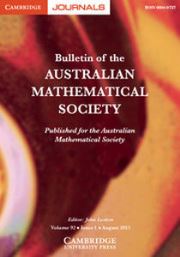 The author of a paper on the properties of a vector space is retracting it from The Bulletin of the Australian Mathematical Society after a “false application” of a theorem led to a “gap in the proof.”
The author of a paper on the properties of a vector space is retracting it from The Bulletin of the Australian Mathematical Society after a “false application” of a theorem led to a “gap in the proof.”
Here’s the abstract of “On a Weakly Uniformly Rotund Dual of a Banach Space,” in full:
Every Banach space with separable second dual can be equivalently renormed to have weakly uniformly rotund dual. Under certain embedding conditions a Banach space with weakly uniformly rotund dual is reflexive.
And the retraction note, published in the August issue of the journal:
The argument in [1] claiming a renorming of a Banach space with separable second dual to have WUR dual is built upon a false application of Goldstine’s Theorem. The author, have noticed this gap in the proof, has retracted the article.
We contacted the editor of the journal, John Loxton, and the author, University of Newcastle mathematician John Giles, for comment. We will update this post if we hear back.
The paper has not been listed by Thomson Scientific’s Web of Knowledge.
Like Retraction Watch? Consider supporting our growth. You can also follow us on Twitter, like us on Facebook, add us to your RSS reader, and sign up on our homepage for an email every time there’s a new post. Click here to review our Comments Policy.
Should the reviewers not have caught the error here?
As a mathematician, I would say not. Certainly world-shaking results are refereed very, very carefully, usually by one or more groups of universally-acknowledged experts in the relevant subject; this was the case with Wiles’s proof of the Fermat Conjecture (and was widely reported in the popular press at the time), and similarly with Perelman’s proof of Thurston’s Geometrization Conjecture and its special case the Poincaré Conjecture (I don’t recall how widely it was reported, but I know people involved). Results with less obvious immediate consequences often (I would say, usually) aren’t refereed anything like that thoroughly. As one of my friends (who has been president of the American Mathematical Society) used to say, the author bears primary responsibility for the truth of the deductions in the paper; referees do the best they can, but may not catch everything. Ideally (and often, if not usually, in practice), when and if a theorem from a given paper is first actually used by someone else, that person will privately re-prove the theorem before applying it, in effect providing “post-publication peer review”. (There was a lot of such re-proving involved in the case of Perelman’s papers.) If enough persons do this, the likelihood of remaining falsehoods in the publication tends to 0. It helps that mathematics (in general) has a much longer half-life, and for that matter a much longer shelf life, than any science I know of, so that the PPPR period can extend over many decades.
I recommend reading Jody Azzouni’s “How and why mathematics is unique as a social practice” (reprinted in Ruben Hersh’s 18 Unconventional Essays on the
Nature of Mathematics). As he writes there (his italics),
Thus mathematics, though indeed “difficult”, is much, much more self-correcting than the sciences seem to be.
Mr Rudolph has taken the care to write a very nice reply. He notes that math is a self correcting discipline. Readers of Retraction Watch should be aware of a long history of retractions in the subject. As well practioners regulary shared information about gaps in proofs.
Errors are found out.
The retraction has been indexed by MathSciNet (which has much better and higher quality coverage than WoK, for papers in maths): http://www.ams.org/mathscinet-getitem?mr=3366464 (paywall for full record). The paper itself is not indexed, probably because the retraction was issued before the paper itself was assigned an issue number.
I find the received and acceptance dates very close together, for a mathematics paper, but that’s not an indication that anything was amiss: the referee might have had not much else to do at the time.
The periodical involved here had, at least initially, the objective of speedy publication. I do not know whether that was still the case when this item appeared?
The reflexive property in mathematics states that any number or geometric object is equal to itself. For example, in algebra, it is shown as \(a = a\). In geometry, it signifies that a line segment, angle, or shape is congruent to itself. This principle is essential for many proofs and logical arguments.